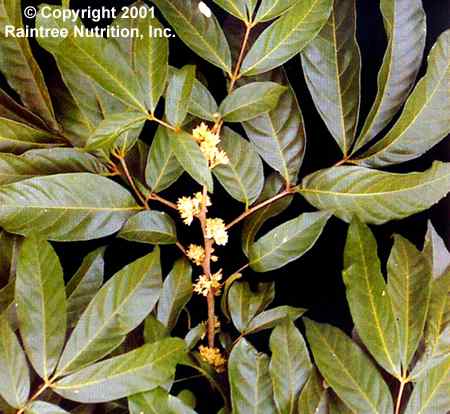Muira puama - Potency Wood

Common Names: Muira puama, marapuama, murapuama, muiratã, potency wood, muiratam, Liriosma ovata, Ptychopetalum olacoides, potency wood (English), bois bandé (origin), potenzholz (German), Muirapuama (international), Marapuama (international), Murapuama (global)
Latin Name: Ptychopetalum olacoides
Origin: South America
Short Introduction
Because Muira puama originates from the Amazonian rainforests, it’s certain that it can’t be cultivated in a backyard garden. Muira puama requires abundant moisture and warmth, all naturally fulfilled in the jungle environment.
Detailed Description
Muira puama is a natural aphrodisiac known for its positive effects on male erectile function!
Botanical Information
Muira puama is a shrubby tree that grows up to five meters tall. Its leaves are dark brown on the underside and light green on the upper side. The small white flowers grow in clusters of four to six and release a spicy aroma reminiscent of jasmine. Ptychopetalum olacoides, the primary botanical source, has a closely related species, Ptychopetalum uncinatum, which is sometimes substituted in folk medicine. However, the olacoides variety is generally preferred for its higher content of the active phytochemical lupeol. The root of Muira puama is extremely hard and light brown at the center, exuding a faint spicy aroma. While all parts of the plant are considered medicinal in the traditional healing practices of indigenous South Americans, the root and bark are most commonly used in phytotherapy.
Origin and Distribution
This plant comes from the Amazonian rainforests of South America, where it is found in Brazil, Suriname, Guyana, and French Guiana. Related species from the genus Ptychopetalum are also found in tropical Africa, where five small tree varieties are native to the region.
Usage / Dosage
As mentioned above, the root and bark are the most commonly used parts of Muira puama. Perhaps its most valued property is its aphrodisiac effect. The name “potency wood” reflects its traditional use for enhancing sexual potency. Among Indigenous peoples, Muira puama is used as a sexual stimulant, often combined with another South American aphrodisiac, catuaba. Research conducted in France on 262 men investigating the efficacy of Muira puama for erectile dysfunction and libido improvement yielded positive results: 61% of men with reduced libido described the effect as dynamic, and 51% of men with erectile dysfunction found it beneficial. Another study focusing on psychological aspects of sexual health reported an 85% increase in libido, a 100% increase in sexual frequency, and a 90% improvement in the ability to maintain an erection. Similarly, research at UCLA School of Medicine confirmed significant improvements in erectile function and sexual desire when using Muira puama root. Modern research confirms what Indigenous peoples have long known, and the potent compounds within Muira puama are becoming increasingly recognized in Western society as sexual stimulants.
Beyond addressing impotence, Muira puama is also used as a nerve tonic, to relieve depression, enhance vitality during weakness, and to address menstrual disorders. As a nerve tonic, it may additionally help with hysteria, anxiety, and stress. Traditionally, it supports neuromuscular health. Applied topically, decoctions are used in massages and baths for paralysis and conditions such as beriberi, as well as for rheumatism.
Active Compounds
The principal bioactive ingredients identified in Muira puama are fatty acids and their esters (abundant especially in the root and bark), plant sterols, triterpenes—particularly lupeol—essential oils, and a unique new alkaloid named muirapuamine.
Traditional Dosage
For extract use: mix 1–2g of extract in 250ml of water; boiling is unnecessary. Do not exceed the recommended daily dose.
